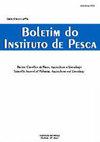DIFFERENT DENSITIES OF COMMON SNOOK REARED IN MARINE CAGES IN SOUTHERN BRAZIL
IF 0.6
4区 农林科学
Q4 FISHERIES
引用次数: 0
Abstract
Two growth stages of juvenile snook (Centropomus undecimalis) under three different densities were evaluated: 10, 20, and 40 fish m-3, in 2.5-m3 cages with 12-mm mesh. In phase I, snooks of 72.0 g and 21.2 cm were raised for 270 days. In phase II, snooks of 204.6 g and 29.2 cm were raised for 202 days. The average water temperature and salinity were 24.3°C and 34.5, respectively, at Santa Catarina Island, Brazil. The data were evaluated using regression models. Density increase did not influence survival rate, with 51.0% (phase I) and 88.7% (phase II). The density of 20 fish m-3 provided the best results, such as body weight, in the two phases, with 215.7 and 364.7 g, respectively. Water temperature was the main limiting factor for the growth of snook. Therefore, in a subtropical climate, it is recommended to start growing in the spring (> 24°C) and avoid handling fish when the temperature is below 20°C. Regression analysis on the final weight showed that densities of 24 fish m-3 could be indicated for common snook under the conditions of this study.巴西南部海洋网箱中饲养的普通鹬的不同密度
在2.5 m3、12 mm网眼、10、20和40鱼(m-3)的3种不同密度条件下,研究了梭子鱼幼鱼的2个生长阶段。第一期分别饲养72.0 g和21.2 cm的小鹿270 d。第二期饲养204.6 g和29.2 cm,饲养202 d。巴西圣卡塔琳娜岛的平均水温和盐度分别为24.3°C和34.5°C。使用回归模型对数据进行评估。密度的增加不影响成活率,分别为51.0%(一期)和88.7%(二期),其中20条鱼m-3的密度在两个阶段的效果最好,如体重,分别为215.7和364.7 g。水温是制约鱼生长的主要因素。因此,在亚热带气候下,建议在春季(> 24°C)开始种植,避免在温度低于20°C时处理鱼。对最终重量的回归分析表明,在本研究条件下,普通鱼的密度可达24条m-3。
本文章由计算机程序翻译,如有差异,请以英文原文为准。
求助全文
约1分钟内获得全文
求助全文
来源期刊

Boletim do Instituto de Pesca
FISHERIES-ZOOLOGY
CiteScore
0.80
自引率
0.00%
发文量
24
审稿时长
>12 weeks
期刊介绍:
To publish original articles of research and short communications in the following áreas: Fisheries, Aquaculture, Zootechnology, Limnology, Oceanography, Biology and Pathology of aquatic organisms. The publication depends on the approval of the Editorial Board, based on the peer review.
 求助内容:
求助内容: 应助结果提醒方式:
应助结果提醒方式:


